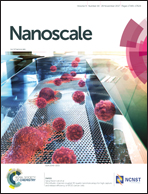Effects of oxidation on the plasmonic properties of aluminum nanoclusters†
Abstract
The scouting of alternative plasmonic materials able to enhance and extend the optical properties of noble metal nanostructures is on the rise. Aluminum is endowed with a set of interesting properties which turn it into an attractive plasmonic material. Here we present the optical and electronic features of different aluminum nanostructures stemming from a multilevel computational study. Molecular Dynamics (MD) simulations using a reactive force field (ReaxFF), carefully validated with Density Functional Theory (DFT), were employed to mimic the oxidation of icosahedral aluminum nanoclusters. Resulting structures with different oxidation degrees were then studied through the Time-Dependent Density Functional Tight Binding (TD-DFTB) method. A similar approach was used in aluminum nanoclusters with a disordered structure to study how the loss of crystallinity affects the optical properties. To the best of our knowledge, this is the first report that addresses this issue from the fully atomistic time-dependent approach by means of two different and powerful simulation tools able to describe quantum and physicochemical properties associated with nanostructured particles.



 Please wait while we load your content...
Please wait while we load your content...